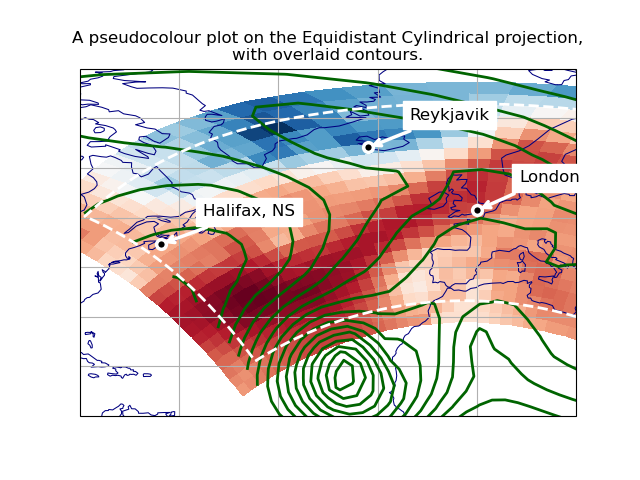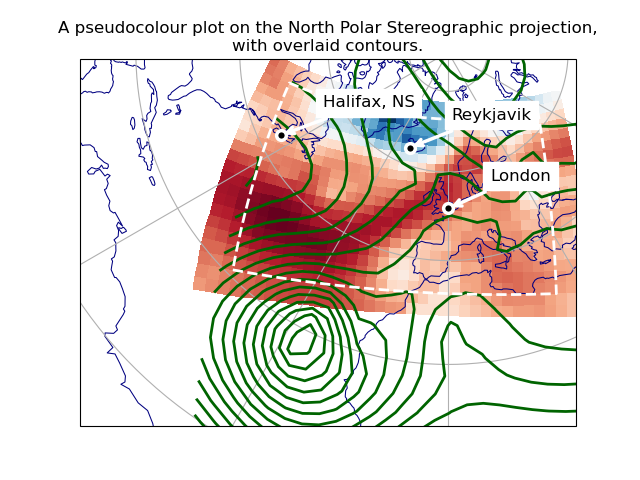Note
Go to the end to download the full example code
Plotting in Different Projections#
This example shows how to overlay data and graphics in different projections, demonstrating various features of Iris, Cartopy and matplotlib.
We wish to overlay two datasets, defined on different rotated-pole grids. To display both together, we make a pseudocoloured plot of the first, overlaid with contour lines from the second. We also add some lines and text annotations drawn in various projections.
We plot these over a specified region, in two different map projections.
import cartopy.crs as ccrs
import matplotlib.pyplot as plt
import numpy as np
import iris
import iris.plot as iplt
# Define a Cartopy 'ordinary' lat-lon coordinate reference system.
crs_latlon = ccrs.PlateCarree()
def make_plot(projection_name, projection_crs):
# Create a matplotlib Figure.
plt.figure()
# Add a matplotlib Axes, specifying the required display projection.
# NOTE: specifying 'projection' (a "cartopy.crs.Projection") makes the
# resulting Axes a "cartopy.mpl.geoaxes.GeoAxes", which supports plotting
# in different coordinate systems.
ax = plt.axes(projection=projection_crs)
# Set display limits to include a set region of latitude * longitude.
# (Note: Cartopy-specific).
ax.set_extent((-80.0, 20.0, 10.0, 80.0), crs=crs_latlon)
# Add coastlines and meridians/parallels (Cartopy-specific).
ax.coastlines(linewidth=0.75, color="navy")
ax.gridlines(crs=crs_latlon, linestyle="-")
# Plot the first dataset as a pseudocolour filled plot.
maindata_filepath = iris.sample_data_path("rotated_pole.nc")
main_data = iris.load_cube(maindata_filepath)
# NOTE: iplt.pcolormesh calls "pyplot.pcolormesh", passing in a coordinate
# system with the 'transform' keyword: This enables the Axes (a cartopy
# GeoAxes) to reproject the plot into the display projection.
iplt.pcolormesh(main_data, cmap="RdBu_r")
# Overplot the other dataset (which has a different grid), as contours.
overlay_filepath = iris.sample_data_path("space_weather.nc")
overlay_data = iris.load_cube(overlay_filepath, "total electron content")
# NOTE: as above, "iris.plot.contour" calls "pyplot.contour" with a
# 'transform' keyword, enabling Cartopy reprojection.
iplt.contour(overlay_data, 20, linewidths=2.0, colors="darkgreen", linestyles="-")
# Draw a high resolution margin line, inset from the pcolormesh border.
# First calculate rectangle corners, 7% in from each corner of the data.
x_coord, y_coord = main_data.coord(axis="x"), main_data.coord(axis="y")
x_start, x_end = np.min(x_coord.points), np.max(x_coord.points)
y_start, y_end = np.min(y_coord.points), np.max(y_coord.points)
margin = 0.07
margin_fractions = np.array([margin, 1.0 - margin])
x_lower, x_upper = x_start + (x_end - x_start) * margin_fractions
y_lower, y_upper = y_start + (y_end - y_start) * margin_fractions
steps = np.linspace(0, 1)
zeros, ones = np.zeros(steps.size), np.ones(steps.size)
x_delta, y_delta = (x_upper - x_lower), (y_upper - y_lower)
x_points = x_lower + x_delta * np.concatenate((steps, ones, steps[::-1], zeros))
y_points = y_lower + y_delta * np.concatenate((zeros, steps, ones, steps[::-1]))
# Get the Iris coordinate system of the X coordinate (Y should be the same).
cs_data1 = x_coord.coord_system
# Construct an equivalent Cartopy coordinate reference system ("crs").
crs_data1 = cs_data1.as_cartopy_crs()
# Draw the rectangle in this crs, with matplotlib "pyplot.plot".
# NOTE: the 'transform' keyword specifies a non-display coordinate system
# for the plot points (as used by the "iris.plot" functions).
plt.plot(
x_points,
y_points,
transform=crs_data1,
linewidth=2.0,
color="white",
linestyle="--",
)
# Mark some particular places with a small circle and a name label...
# Define some test points with latitude and longitude coordinates.
city_data = [
("London", 51.5072, 0.1275),
("Halifax, NS", 44.67, -63.61),
("Reykjavik", 64.1333, -21.9333),
]
# Place a single marker point and a text annotation at each place.
for name, lat, lon in city_data:
plt.plot(
lon,
lat,
marker="o",
markersize=7.0,
markeredgewidth=2.5,
markerfacecolor="black",
markeredgecolor="white",
transform=crs_latlon,
)
# NOTE: the "plt.annotate call" does not have a "transform=" keyword,
# so for this one we transform the coordinates with a Cartopy call.
at_x, at_y = ax.projection.transform_point(lon, lat, src_crs=crs_latlon)
plt.annotate(
name,
xy=(at_x, at_y),
xytext=(30, 20),
textcoords="offset points",
color="black",
backgroundcolor="white",
size="large",
arrowprops=dict(arrowstyle="->", color="white", linewidth=2.5),
)
# Add a title, and display.
plt.title(
"A pseudocolour plot on the {} projection,\nwith overlaid contours.".format(
projection_name
)
)
iplt.show()
def main():
# Demonstrate with two different display projections.
make_plot("Equidistant Cylindrical", ccrs.PlateCarree())
make_plot("North Polar Stereographic", ccrs.NorthPolarStereo())
if __name__ == "__main__":
main()
Total running time of the script: (0 minutes 0.631 seconds)
-3.8.1-green?style=flat)

